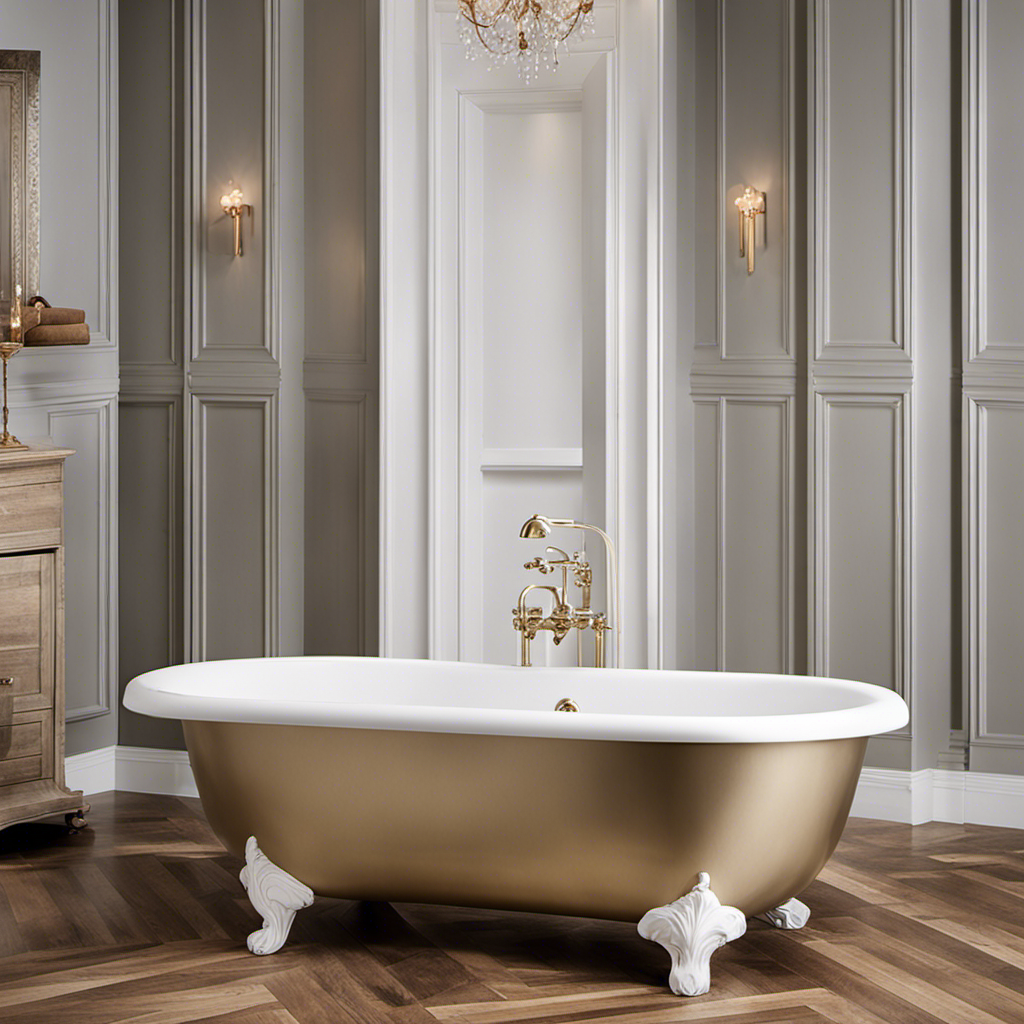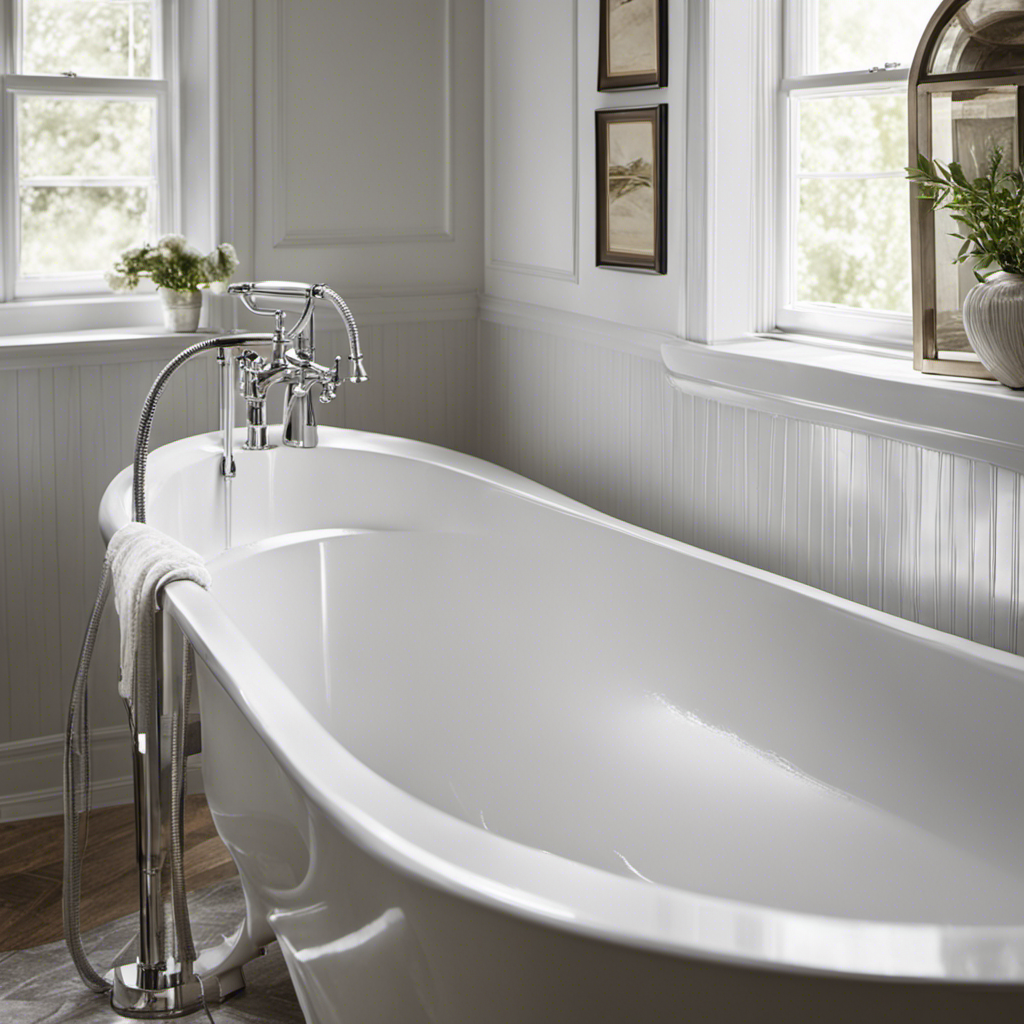Did you know that a properly framed bathtub not only provides stability and support, but also ensures a safe and long-lasting installation?
In this article, I will guide you through the process of framing in a bathtub step by step.
From planning and measuring to installing studs and securing surrounding walls, you’ll learn the essential techniques to create a sturdy and functional frame for your bathtub.
So let’s get started and make sure your bathtub is framed right!
Key Takeaways
- Proper measuring and marking is crucial for accurate bathtub framing.
- Evenly spacing and securely attaching studs is essential for a strong and stable bathtub frame.
- Reinforcing the frame with straps and a waterproof barrier helps to prevent wobbling and moisture damage.
- Choosing the right bathtub materials and securing the surrounding walls are important for durability and protection against water seepage.
Planning and Preparation
Before starting the framing process, it’s important to make sure you have all the necessary tools and materials. When it comes to bathtub installation, proper framing techniques are crucial for ensuring stability and longevity.
To begin, you will need a tape measure, level, pencil, framing square, circular saw, and hammer. Additionally, gather 2×4 wooden boards, screws, and construction adhesive.
Measure the dimensions of the bathtub and mark the outline on the floor. Next, determine the layout of the framing, ensuring it aligns with plumbing and electrical requirements.
Cut the 2×4 boards to the appropriate lengths and attach them securely to the floor and walls, using the framing square to ensure accurate angles.
By following these bathtub framing techniques, you will lay a solid foundation for a successful installation.
Now, let’s move on to measuring and marking the exact location for the bathtub.
Measuring and Marking
While measuring and marking, it’s important to ensure accurate dimensions. This step is crucial in framing a bathtub properly. Here are three essential measuring techniques and marking tools to help you achieve precise results:
-
Use a measuring tape: Measure the length, width, and height of the bathtub area. Make sure to account for any obstructions or irregularities in the walls or floor.
-
Marking pencil or chalk: Use a marking pencil or chalk to mark the measurements on the walls and floor. This will serve as a guide when cutting or installing the framing materials.
-
Level and square: Use a level to ensure that the marked lines are straight and plumb. Additionally, use a square to ensure the corners are square, which is crucial for a stable and balanced frame.
Installing the Studs
When it comes to installing studs, there are a few key points to keep in mind for a successful outcome.
First, it’s important to have some stud placement tips in mind to ensure the studs are evenly distributed and properly aligned.
Additionally, proper stud spacing is crucial for structural integrity, so measuring and marking the proper intervals is essential.
Stud Placement Tips
One tip for stud placement is to use a stud finder to locate the studs in the wall. This handy tool will save you time and ensure that your studs are positioned correctly for optimal support.
Once you have located the studs, here are three important considerations for stud placement:
-
Stud framing techniques: When framing in a bathtub, it is important to follow proper stud framing techniques. This includes spacing the studs evenly and securely attaching them to the wall. By using the correct framing techniques, you can ensure that your bathtub is properly supported and will not sag or shift over time.
-
Waterproofing considerations: Since a bathtub is a wet area, it is crucial to consider waterproofing when placing the studs. This may involve using moisture-resistant materials, such as pressure-treated wood or waterproof membranes, to protect the studs from water damage. Proper waterproofing will help prevent mold and rot, ensuring the longevity of your bathtub framing.
-
Accessibility: Another important factor to consider when placing studs for a bathtub is accessibility. Ensure that the studs are positioned in a way that allows for easy installation of plumbing fixtures and future maintenance. This will make any necessary repairs or upgrades much simpler and less disruptive.
Proper Stud Spacing
To ensure optimal support, make sure you space your studs evenly and securely attach them to the wall. Proper stud spacing is crucial for a strong and sturdy bathtub frame.
One of the most common mistakes people make is not spacing their studs evenly. This can lead to an unstable frame and potential problems down the line.
Another common mistake is not securely attaching the studs to the wall. This can result in a wobbly frame and a bathtub that is not properly supported.
To avoid these issues, it is important to use waterproofing techniques when framing in a bathtub. This includes using moisture-resistant materials and sealing all joints and seams to prevent water damage.
Tools for Stud Installation
Now that we have established the proper spacing for the studs, it’s time to move on to installing them. To get started, you will need a few essential tools:
-
Hammer: This will be used to secure the studs into place and ensure they are tightly fastened.
-
Level: A level is crucial for ensuring that the studs are perfectly vertical and level. This will prevent any issues when installing the bathtub.
-
Brackets: Brackets are used to provide additional support to the studs. They help to prevent any potential sagging or instability.
Once you have gathered these tools, you can begin installing the studs. Start by placing the studs between the top and bottom plates, making sure they are evenly spaced according to your measurements. Use the level to ensure they are plumb and level. Then, secure the studs in place using the hammer and brackets.
With the studs properly installed, we can now move on to the next step of adding support for the tub.
Adding Support for the Tub
When it comes to adding support for the tub, there are three key points to consider: properly securing the tub, reinforcing structural integrity, and choosing appropriate materials.
Properly securing the tub involves ensuring it is level and securely fastened to the surrounding framework.
Reinforcing structural integrity can be achieved by adding additional support beams or braces underneath the tub.
Lastly, choosing appropriate materials such as strong and durable lumber or metal brackets will help ensure the long-term stability and safety of the tub installation.
Properly Securing the Tub
Make sure you’re using the appropriate tools and materials for properly securing the tub. Here are three important steps to consider when securing the tub:
-
Install securing brackets: Use sturdy metal brackets to secure the tub to the framing. These brackets provide stability and prevent any movement or shifting of the tub during use. Make sure to follow the manufacturer’s instructions for proper installation.
-
Apply waterproofing techniques: Before securing the tub, it’s essential to apply waterproofing techniques to protect the surrounding area from water damage. Use a waterproof membrane or a waterproof sealant to create a watertight barrier between the tub and the walls or floor.
-
Secure the tub to the studs: Use screws or nails to secure the tub flange to the wall studs. This ensures that the tub is firmly attached to the framing and prevents any potential movement or shifting over time.
Reinforcing Structural Integrity
To reinforce the structural integrity of your installation, ensure that you are using strong and durable materials. When framing in a bathtub, it’s essential to employ various reinforcing techniques to ensure a sturdy and long-lasting structure.
Firstly, use pressure-treated lumber for the framing, as it is more resistant to moisture and decay. Additionally, consider using metal brackets or straps at the corners and joints to provide extra support. These reinforcements will help prevent any wobbling or shifting over time.
Furthermore, it is crucial to incorporate proper waterproofing methods to protect the framing from moisture damage. Apply a waterproof membrane or sealant to the framing and surrounding areas, such as the walls and floor, to create a barrier against water penetration.
Choosing Appropriate Materials
Start by selecting strong and durable materials for your installation, ensuring its long-lasting integrity. When it comes to bathtub material options, there are several choices to consider. Here are three popular options along with their pros and cons:
-
Acrylic: Acrylic bathtubs are lightweight and easy to clean. They retain heat well and come in a variety of shapes and sizes. However, they can be prone to scratching and may fade over time.
-
Cast Iron: Cast iron bathtubs are known for their durability and timeless appeal. They retain heat effectively and are resistant to scratches and fading. However, they are heavy and may require additional support during installation.
-
Fiberglass: Fiberglass bathtubs are affordable and lightweight. They are resistant to scratches and stains, making them easy to maintain. However, they may not retain heat as well as other options and can be prone to cracking if not handled carefully.
Consider your specific needs and budget when choosing the right material for your bathtub installation.
Securing the Surrounding Walls
First, you’ll need to secure the surrounding walls before installing the bathtub. There are several waterproofing methods that you can use to ensure that the walls are protected from moisture.
One option is to apply a waterproofing membrane, such as a liquid or sheet membrane, to the walls. This will create a barrier that prevents water from seeping into the walls.
Another option is to use a waterproofing paint or coating. These products are designed to create a waterproof barrier on the walls.
Once you have waterproofed the walls, you can consider the finishing options. You can choose to tile the walls for a sleek and modern look, or you can use a moisture-resistant paint for a more budget-friendly option.
Now that the walls are secure and waterproofed, you can move on to completing the frame.
Completing the Frame
Now that the surrounding walls are secure, it’s time to focus on completing the frame for your bathtub. This step is crucial in ensuring the stability and longevity of your installation.
To start, here are three key steps to complete the frame:
-
Adding insulation: Insulating the frame helps prevent heat loss and reduces noise transmission. Use fiberglass insulation or foam boards to fill the gaps between the studs, ensuring a snug fit.
-
Applying waterproofing techniques: It’s essential to protect your walls from moisture damage. Apply a waterproofing membrane, such as a liquid or sheet membrane, to the exposed areas around the frame. This will create a barrier against water, preventing leaks and potential issues down the line.
-
Securing the subfloor: Before installing the bathtub, make sure the subfloor is sturdy and level. Use screws to secure any loose boards and ensure a solid foundation for your bathtub.
Conclusion
Well, there you have it folks! Framing in a bathtub may seem like a daunting task, but with proper planning and a little elbow grease, you’ll be soaking in tranquility in no time.
Remember to measure twice and cut once, because nobody wants a wonky tub. And don’t forget to secure those walls tightly, unless you want a surprise flood party.
So go forth and frame, my fellow bath enthusiasts, and may your tubs be sturdy and your bubbles abundant.
Happy framing!










